Angels
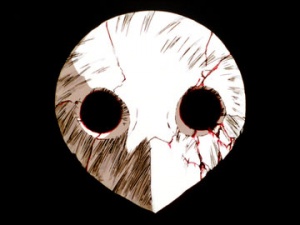
Angel (使徒, shito) is an ambiguous term that has various meanings within the Evangelion mythos depending on context.
Usage
As most commonly used in the show and elsewhere, the word "Angel" refers to any of Adam's fifteen children, whom Nerv must systematically destroy over the course of the story. Adam itself, the designated "First Angel", is occasionally included with its offspring when speaking of Angels collectively.[1]
However, considering Seele's list of designated "Angels" in full, it includes entities as disparate as the Seeds of Life (1st: Adam and 2nd: Lilith[2][3]), the natural progeny of Adam (3rd~16th), the human-shaped vessel of Adam's soul (17th: Kaworu Nagisa), and Homo sapiens itself (18th: Lilin).
This conflict between the heavily-reinforced concept of "Angel" (god-like beings antithetical to human life) and the more inclusive version rightfully raises the question of what an Angel is actually intended to be. Evangelion plays a similar game with terms related to humanity (hito, ningen, and jinrui).
Analysis
One possibility is that "Angel" actually refers to all beings whose origin is ultimately traceable to the First Ancestral Race. This species, the prototypical humans of NGE, produced the Seeds of Life in order to propagate new lifeforms on distant worlds, into which the F.A.R.'s souls would be reincarnated.[4] Consider also that both "angel" and "apostle" (the literal meaning of Angel's Japanese equivalent, shito) inherently mean "messenger". Furthermore, the F.A.R. are stated to be esteemed as gods by Adam's children and the Lilin.[5] (On a perhaps related note, Rei muses, "What is a human? A creation of God? Is man a human creation?")[6] "Angels", then -- which we know to refer to both Seeds of Life and their progeny -- could be thought of as "messengers" for their "God(s)". The "message" to be disseminated is humanity itself.
Translation

|
"Making something... Nurturing something is really great. You can see and learn so many things from the process." |
The characters in NGE are actually calling the Angels "shito", which means "apostle", while the Japanese word normally used for the western concept of Angel is "tenshi". However, this isn't a translation mistake on the part of NGE's U.S. distributors. The "Angel" designation is clearly seen in the show's opening and at various times within the show itself, and the word "Angel" was retained in the English version of the show at the request of the show's Japanese creators[Source needed].
At one point in the show's production, the term "Apostolo" was going to be used as a counterpart to "shito" instead of "Angel".
Adam's Children
Adam’s children (アダムの子供達, Adamu no kodomotachi)[7] refers to the Angels originated from the Seed of Life Adam.
In the Neon Genesis Evangelion TV series, Adam's children encompass the Third through Seventeenth Angels (manga: Third through Twelfth). The first thirteen are Adam’s natural offspring (upon whom this article will focus). Adam’s last child, Tabris, is the result of an experiment in which Lilin genes fused into Adam.
Adam's children began appearing around Tokyo-3 fifteen years after Second Impact, starting with the 3rd Angel, Sachiel. It is assumed that the Angels' intention is to cause Third Impact and reclaim Earth from Lilith's children (Homo sapiens). The Evangelions' task is to protect mankind by defeating Adam's children, in accordance with both Gendo Ikari's and Seele's plans.
Nature
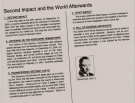
|
"The story presented to the public was just a cover-up." |
Despite being segregated into separate “Angels” (Third, Fourth, etc.), Adam’s children essentially comprise a single race of humanity – one possible variation upon a theme. (The Lilin are another.) They are described as “humans who cast aside human form”. Accordingly, they appear to begin life as humanoid entities, developing embryologically in perhaps the same way as Adam or an Eva would. Going by Sandalphon, the Angels develop inside oblong objects resembling eggs, compared in the show to a chrysalis. After developing to an indeterminate point[8], the Angel's human form is “rejected”. Immediately prior to hatching (again, going by Sandalphon's precedent), the Angel undergoes a spontaneous metamorphosis into its "adult form", then emerges from its "chrysalis".[9]
How the form is selected and its structure determined is entirely unknown. The A.T. Field appears to play some role in Angel metamorphoses. Taken together with what is said about the role of the A.T. Field elsewhere in the show, this implies that perhaps each Angel’s form is a tangible manifestation of its self-image. That is, where Lilin are more or less constrained to a common form, and must express their individuality in subtler ways, Adam’s children can simply be whatever they imagine themselves to be.
The genetic pattern of Shamshel is reported to possess a 99.89% similarity to that of humans (Homo sapiens). While no comment is made on Shamshel’s brethren, this similarity can be deduced to apply universally to the group. In Sadamoto’s manga, the same percentage is applied to the Evas, implying, at least in Sadamoto’s view, the same genetic origins, which would be Adam. Of note here is that metamorphosis has no apparent effect on the Angels’ biological blueprints, indicating that it must operate on a more metaphysical level.
Origins
How Adam generated its offspring is completely unknown. Explanations can be as disparate as "pieces of Adam blown off at Second Impact grew into the various Angels" to "Adam laid the Angels' eggs billions of years ago, but didn't give them souls until the day of Second Impact, when they were scattered by the explosion". The proposed theories have varied pros and cons.
Whether the Angels existed in some form prior to September 13, 2001, or only came into being on that very day, it doesn't seem to be any coincidence that Adam opened its Doors of Guf on Second Impact (implying the release of souls), and its children began to "appear" fifteen years later.
See Also: Angels' Origins.
Motivations & Psychology
The cues in the show itself regarding the Angels intentions are varied and ambiguous. Some of them lend the common impression that the Angels are trying to return to Adam, in automaton-like manner, although the Angels' behavior is hardly consistent enough to support this. One explanation of their motivations, found in the Classified Information states, "Some of them were trying to access Lilith and reset all life, some of them had nothing in mind, and some were trying to recover their progenitor Adam."
Adam's children are generally uncommunicative, and the forms they take tend to be inexpressive, with the result that we have little insight into their thoughts. However, some is provided by Leliel, Arael, and Armisael, who engage the Eva pilots in forms of communication. Some of the Angels also provide some insight into their psychology through their behavior, such as Sachiel and Zeruel.
See also: Angel Psychology.
Common Traits
While each of Adam’s children has a form unique to itself, there are many traits common to or prevalent among the group. (Some of these, in turn, can be found in other so-called "Angelic" lifeforms, such as the Seeds and Evas.)
A.T. Field
All of Adam’s children have souls and, hence, A.T. Fields. Their A.T. Fields are much more powerful than those of LCL-based lifeforms, giving them various paranormal, especially psychokinetic, abilities. Common utilizations include barriers ("force fields"), levitation, and metamorphosis.
See Also: A.T. Field
Blood
Blood is observed for many of Adam’s children, including: Sachiel, Ramiel, Leliel, Bardiel, Zeruel, Arael, and Armisael. It is red in all instances save for Sachiel, whose is blue (albeit changed in Rebuild to adhere to the norm). It is unclear why, or how, Angels whose forms seem to preclude the possession of circulatory systems possess blood. On one level, it might be considered a visceral reminder of their intrinsically human nature.
In the Rebuild continuity, the Angels dissolve into a red fluid resembling blood when their cores are destroyed, attributed to the collapse of their A.T. Fields.[10] This is possibly an analogue to LCL.
Blood Type
Most register “Blood Type Blue”. “Orange” is seen on some rare occasions (Leliel's spherical shadow and Eva-03 parasitized by Bardiel; Armisael cycles between orange and blue when it first appears). What “Blood Type” actually refers to is unclear.
See Also: Blood Type
Core
The core is a spherical red organ containing the soul and S² Engine. Observed in nearly all of Adam’s children. This feature derives from Adam.
See Also: Core
Energy Projection
Several Angels demonstrate an ability to harness energy to trigger explosions or generate focused energy beams / energy-based projectiles. Angels possessing eyes -- Sachiel, Israfel, and Zeruel -- involve them in the energy projection process, although it's not entirely clear how this works. (I.e., if the eyes actually emit the energy, or if they simply act as a "focal point" of some sort.)
Both Sachiel and Zeruel are capable of projecting the infamous cross-shaped explosions. Eva-01 and Eva-02 appear to have the same ability, suggesting that it perhaps "runs in the family".
Regeneration
Most Angels are capable of enduring vast amounts of physical damage. As long as an Angel's core and S² Engine is intact, it can theoretically regenerate the damaged tissue, given enough time.
S² Engine / Fruit of Life
Possessed by all of Adam’s children. The source of their theoretically limitless motive energy. Despite the name, the S² Engine appears to be organic in nature.
See Also: S² Engine & Fruit of Life
List of Angels
This is a breakdown of all numbered Angels according to the three main Evangelion continuities.
Seele is thought to obtain the Angel names and ordinals from the Secret Dead Sea Scrolls. It is unclear why entities such as the Evangelions (copies of the Seeds) and Rei Ayanami (Lilith's "answer to" Tabris) are not included, since they would seem to possess all of the required qualifications, under the more expansive definition of "Angel".
According to a statement made by Gendo in Evangelion 1.0, seven Angels remain to be defeated after the Sixth (Ramiel).
| Thumbnail | Name | Description | Ordinal | ||
|---|---|---|---|---|---|
| NGE | Manga | Rebuild | |||
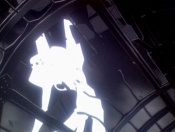
|
Adam | The first human on Earth. Progenitor of all "Angelic" Angels. | 1st | 1st | ? |

|
Lilith | Progenitor of mankind (Lilin) and all other LCL-based organisms on Earth. | 2nd | 2nd | 2nd |
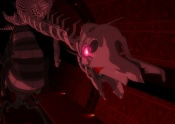
|
Third Angel | Discovered in permafrost prior to Sachiel's attack. Fought Evangelion Unit-05 at Bethany Base in Evangelion 2.0. | - | - | 3rd |
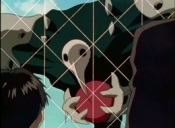
|
Sachiel | First Angel to be encountered in the series. An amphibious humanoid Angel. | 3rd | 3rd | 4th |
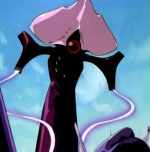
|
Shamshel | Arthropod-like Angel with deadly "whips of light". | 4th | 4th | 5th |
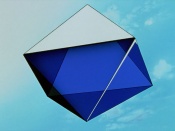
|
Ramiel | Extremely powerful octahedral Angel with deadly particle beam and immensely strong A.T. Field. | 5th | 5th | 6th |
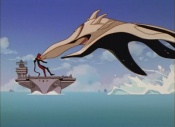
|
Gaghiel | Aquatic Angel the size of an aircraft carrier. | 6th | 6th | - |

|
Seventh Angel | An incredibly tall clock-like Angel. | - | - | 7th |
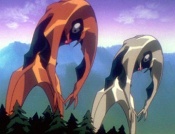
|
Israfel | Angel capable of merging into one body and acting in concert even when separate. | 7th | 7th | - |
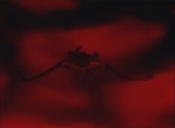
|
Sandalphon | Rapidly matured while still in embryonic stage in volcano. Capable of withstanding extremes of temperature and pressure. Resembles the Cambrian predator Anomalocaris. | 8th | - | - |
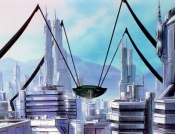
|
Matarael | Four-legged spider-like Angel that secretes acid from its ventral eye. | 9th | - | - |
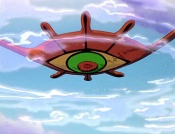
|
Sahaquiel | Monstrous Angel that threatens to destroy Tokyo-3 by falling on the city from low earth orbit. | 10th | Unnumbered[11] | 8th |
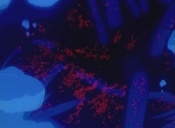
|
Ireul | Microscopic Angel that appears deep inside Nerv Headquarters. Capable of hacking into computer systems. | 11th | - | - |
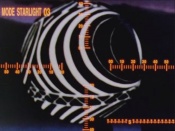
|
Leliel | Angel with a black hole-like shadow body that exists in higher dimensions. | 12th | - | - |
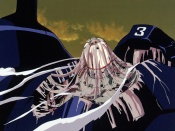
|
Bardiel | Has a physical structure similar to a slime fungus. Parasitizes and gains control over Evangelion Unit-03. | 13th | 8th | 9th |
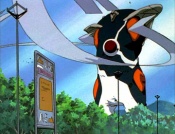
|
Zeruel | Extremely powerful Angel with strong A.T. Field and no shortage of destructive power. Meets an especially brutal fate. | 14th | 9th | 10th |
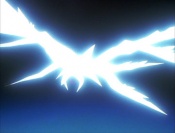
|
Arael | Glowing suborbital bird-like Angel that probes minds with a beam of light. | 15th | 10th | - |

|
Armisael | First appears as a glowing double helix. Capable of changing form and fusing with an Eva. | 16th | 11th | - |

|
Tabris | Ostensibly a fifteen year old human male. Vessel of Adam's soul. | 17th | 12th | ? |
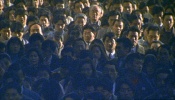
|
Lilin | Humans -- as we tend to think of them. | 18th | 13th | ? |
Angels in Rebuild
The Third through Tenth (beyond are not yet announced) Angels in Rebuild, while narratively equivalent to Adam's children, have not yet had their origins divulged.
References
- ↑ Episode 12:
- Misato: "Destroying Angels is my duty."
Ritsuko: "Your duty? Don't make me laugh. This is for your own sake, isn't it? Your revenge against the Angels!" - Misato: "The only thing that was clear to me was I wanted to destroy the Angels who caused the Second Impact. So in order to do that, I joined Nerv."
- Misato: "Destroying Angels is my duty."
- ↑ Lilith's designation as the Second Angel is never provided in-show, although it can be reasonably deduced due to the fact that no Second Angel is ever named, and Lilith is never assigned an ordinal. Its status as Second Angel is stated outright in several supplemental canonical sources (including Bandai's collectible card game, the Classified Information, and Evangelion Chronicle). It is also stated directly in the Rebuild canon:
- Evangelion 1.0: You Are (Not) Alone. Misato (showing Shinji the giant in Central Dogma):
- "[This is] the bringer of life to this planet, and the agent of its extinction. The Second Angel, Lilith."
- Evangelion 1.0: You Are (Not) Alone. Misato (showing Shinji the giant in Central Dogma):
- ↑ Episode 26'. Misato: "Shinji-kun, we humans were born from the one called Lilith -- a source of life, just like Adam. We are the 18th Angel."
- ↑ Neon Genesis Evangelion 2: Another Cases. Kaworu's Scenario: Good Ending.
- ↑ Neon Genesis Evangelion 2. Classified Information. First Ancestral Race.
- ↑ Neon Genesis Evangelion. Episode 14. Platinum subtitles.
- ↑ The collective grouping has no unique canonical name, although the phrase “Adam’s children” was used by Misato in a preliminary draft for Episode 25’.
- ↑ In episode 10, Ritsuko says that Sandalphon hatched sooner than expected, leaving the “norm” unknown.
- ↑ While the terms used invite an insect analogy, there is no canonical evidence that the Angels had a free-moving "pupal" stage at some point and later cocooned themselves. Rather, "chrysalis" seems to apply to the extent that the entity it contains undergoes a drastic metamorphosis before emerging.
- ↑ Evangelion 1.0: You Are (Not) Alone:
- (observing the crater of "blood" left by Sachiel's self-destruction)
- Ritsuko: "The collapse of the Angel's A.T. Field was more destructive than we predicted."
- Ibuki: "This blood is like a lake from hell... It reminds me of the Second Impact."
- ↑ Sadamoto skips from 7th Angel (Israfel) to 8th Angel (Bardiel), despite having the Evas sortie against Sahaquiel in between.
| Angels |
| Angels (general) |
| First and Second Angels (Seeds of Life): Adam | Lilith |
| Third to Seventeenth Angels (Adam's Children): |
| Sachiel | Shamshel | Ramiel | Gaghiel | Israfel | Sandalphon | Matarael | Sahaquiel |
| Ireul | Leliel | Bardiel | Zeruel | Arael | Armisael | Tabris |
| Eighteenth Angel: Lilin |
| Rebuild of Evangelion: ?Adams? | Lilith | 3rd Angel | 4th Angel | 5th Angel | 6th Angel | 7th Angel | 8th Angel | 9th Angel | 10th Angel | 11th Angel | 12th Angel | 1st/13th Angel |
| Other: Extracanonical Angels |
